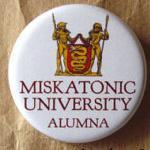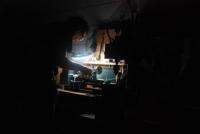Question Metal of the common Sidhe
- Cryptic
-
 Topic Author
Topic Author
I am a caffeine heathen; I prefer the waters of the mountain over the juice of the bean. Keep the Dews coming and no one will be hurt.
- Malady
-

- null0trooper
-

One could look into the effectiveness of gilding and tinning armor for appearance and to reduce direct exposure, but there should be an arming coat/gambeson between the armor and the body.
Forum-posted ideas are freely adoptable.
WhatIF Stories: Buy the Book
Discussion Thread
- Kristin Darken
-

On the other hand, the royal guard and executioners probably have a whole 'protocol' and tradition about carrying, drawing and using it... akin to the way fighter pilots handle munitions. They have it on hand, but need verbal confirmation/orders to draw and use it.. and doing so without orders might be the end of your career or life, if your review board says it was unwarranted.
Fate guard you and grant you a Light to brighten your Way.
- Cryptic
-
 Topic Author
Topic Author
I am a caffeine heathen; I prefer the waters of the mountain over the juice of the bean. Keep the Dews coming and no one will be hurt.
- Malady
-

Cryptic wrote: Cool, for somereason ceramics didn't come to my mind.
Well, I'm not up to date on the latest sword materials, and when you say "ceramic", I think, "fragile".
- Cryptic
-
 Topic Author
Topic Author
"NO!!!"
I am a caffeine heathen; I prefer the waters of the mountain over the juice of the bean. Keep the Dews coming and no one will be hurt.
- E. E. Nalley
-

Or as Dead Gentlemen Productions so eloquently put it:
The Gamers: Dorkness Rising wrote: "A light saber? You have a light saber on your character sheet?"
"I see no light saber; that would be a violation of copy right. This, is a Psionic Blade."
I would rather be exposed to the inconveniences attending too much liberty than to those attending too small a degree of it.
Thomas Jefferson, to Archibald Stuart, 1791
- Sir Lee
-

- Mister D
-

Malady wrote:
Cryptic wrote: Cool, for somereason ceramics didn't come to my mind.
Well, I'm not up to date on the latest sword materials, and when you say "ceramic", I think, "fragile".
Concrete is a form of ceramic. Not exactly useful for making blades, though that gives me an idea... (Fading sound of footsteps moving away quickly. Lab Door slams.)
Doped ceramics, and carbon-fiber, exist in our narrative universe, so they'll be available in WU.
If they have access to air elementals, then they'll have access to sufficient electricity to be able to use aluminium/titanium on larger scale.
Also we still haven't finished experimenting with the creation and testing of even basic alloys, so there's no telling what exotic alloys made from basic elements they may have come up with.
It does not mean that they'll be easy or safe to work.
"Radioactives have half-lives, but Arsenic is forever," as one of my old lecturers was wont to say when teaching lab safety protocols. He wasn't worried about you killing yourself. He was worried about the effects of your actions on everybody else.
Arsenous acids are incredibly useful, and ridiculously unsafe.
Measure Twice
- null0trooper
-

Mister D wrote: If they have access to air elementals, then they'll have access to sufficient electricity to be able to use aluminium/titanium on larger scale.
My impression was that mithril filled that niche, but materials costs could reverse that.
Forum-posted ideas are freely adoptable.
WhatIF Stories: Buy the Book
Discussion Thread
- Kristin Darken
-

Malady wrote:
Cryptic wrote: Cool, for somereason ceramics didn't come to my mind.
Well, I'm not up to date on the latest sword materials, and when you say "ceramic", I think, "fragile".
And as far as contemporary state of the art sword materials goes, ceramic is generally about as viable as, say, obsidian. It is very hard - diamond hard - and capable of extremely sharp edges that do not easily blunt. However, like many extremely hard materials, it is subsequently brittle and will chip and/or shatter under impact. As such, you see it in combat weapons and it is only seen in 'kitchen' knives. Even there, it doesn't catch on as much as it could because you have to have special equipment to sharpen them once they dull.
As far as combat goes...no one fighting in traditional European sword forms is going to give up the ability to hack and parry (the sword of fighting that would result in a shattered blade). That doesn't mean that a purely 'clean cut' slicing combat couldn't grow out of the use of a weapon. It would be completely unique to us, in the way that the martial arts of Dune was designed to function through kinetic dampeners.... we would never fight in such a style because there simply is no reason to. But in context? Why not?
Just for a start, I imagine such a style to include similarities to iaijutsu and court sword fencing.. Part of the 'fame' of dueling in such a technique might be tied to the age of the blade... ie. he has won 27 duels using the blade named Aeriaca. A sign not only of victory, but of 'flawless' technique resulting in sufficient cuts/injuries for an opponent to yield but without causing damage to the blade itself.
Fate guard you and grant you a Light to brighten your Way.
- Sir Lee
-

Ceramics as a rule are not known for their flexibility, no. But they can be extremely hard wearing, ridiculously smooth and endure heat much better than metals.
Ceramic knives are almost impossible to hone unless you have special equipment, but OTOH if you care for them properly they will hold that edge for a long, long time.
And then there are composites, which are hardly a modern invention. Composite bows (not to be mistaken for compound bows , which are more recent than the Beatles) have a long history.
- Bek D Corbin
-

- Mister D
-

Bek D Corbin wrote: I remember, here and there, brief mentions of faerie knights wielding swords and wearing armor 'forged' of glass- strong as steel, sharp enough to slice a hope in half
In Julian May's "Many Coloured Land" series, the sapients that became known as "Elves", "Dwarves", and "Trolls", were a non-human, but genetically compatible race from another galaxy, that lived on earth so long ago, that only vague stories were left.
Edit: Sorry, my bad. The series is known as "The Saga of The Exiles". "The Many Coloured Land" is the name of the first book.
They were vulnerable to "blood metal" (Iron) that disrupted the psionic matrices that they required to stay alive. ( -Ish, but it's the simple explanation that doesn't spoil the story.)
One of the materials that they used was "Vitredur", a cera-metal composite made from doped silicon, that had the above properties.
A number of engineers inspired by these stories, and other tales, have been trying to make these materials, which was one of the inspirations behind the ceramics that Sir Lee mentions above.
They are not hard to make in small quantities, but it's getting them made to a consistent standard that's a more difficult process, but that's just another practical engineering problem. The base science is already there.
Having an Fore-Runner species with exotic materials based upon the same underlying physics of the reality we live in works.
Sir Lee: There were experiments, and prototypes made by Ford, of ceramic engines. They worked really effectively, but lasted too long for the company's liking. Cut too far into the profit margins that the "Planned Obsolescence" business models requirs. At uni, through one of our lecturers, we had a talk from one engineer who was working on those systems in the late 1950's/early-1960's. Chewy insights into materials technology.
Measure Twice
- Schol-R-LEA
-

Stories of super-durable glass are ancient, going back at least to the time of Roman Emperor Tiberius and the legendary ' vitrum flexile '.
Out, damnéd Spot! Bad Doggy!
- Cryptic
-
 Topic Author
Topic Author
You add the right catalysts, kiln it proper, this stuff is stronger'n steel ten times over, at half the weight."Malady wrote:
Cryptic wrote: Cool, for somereason ceramics didn't come to my mind.
Well, I'm not up to date on the latest sword materials, and when you say "ceramic", I think, "fragile".
-Firefly
Ceramic chiefs knives...
I am a caffeine heathen; I prefer the waters of the mountain over the juice of the bean. Keep the Dews coming and no one will be hurt.
- lighttech
-

Well in my fan fic stuff and owned stories my Drow or elves forge Mithril with other metals, as mithril is more of a magic battery or carrier or a way to tune in essance for use.Malady wrote: Maybe the commoners mainly use bows and magic, and swords and stuff are reserved for nobility, and use Mythril and Adamant, and stuff to make those?
then add it can IMO be forged with magical mineral glass, this making the blade extremely strong and the edge sharp as that same glass
Or in one case a drgon's hair was inserted along each blades edge and that magic creature's durability added to the blade along with the hair's innate ability to cut much like a single nano edge might!
Bows can work the same way with woods blended via magic with themselves or metal or other and bow strings the same way
then add my Drow loves poisons that will drop you in your tracks and make your body a gooey mess!!!
want ideas hit me up!
Part of the WA Drow clan/ collective
Author of Vantier and Shadowsblade on Bigcloset
- E. E. Nalley
-

Cryptic wrote:
You add the right catalysts, kiln it proper, this stuff is stronger'n steel ten times over, at half the weight."Malady wrote:
Cryptic wrote: Cool, for somereason ceramics didn't come to my mind.
Well, I'm not up to date on the latest sword materials, and when you say "ceramic", I think, "fragile".
-Firefly
Yes! Yes, I want to buy some mud!
I would rather be exposed to the inconveniences attending too much liberty than to those attending too small a degree of it.
Thomas Jefferson, to Archibald Stuart, 1791
- Anne
-

Ceramic? You can get pretty darn sharp (think glass [oh and there is that too!]) and use them as a sort of serrated edge on a brass blade if necessary, not that they can't be formed into effective blades on their own... remember that obsidian, a form of volcanic glass was used for edged tools long before metals were commonly worked!
Adopt my story: here
Nowhereville discussion
- Astrodragon
-

Anne wrote: Actually some of the brass alloys are pretty darn hard. Not as hard a steel mind, but still, petty darn hard. They would make common blades, and even swords. So I wouldn't entirely discount them. I have a whole set of brass tools from working in plastics for a long time, most of them aren't as hard as steel, but that was because when you use certain tools near your steel molds, you don't want to scar/score the mold...
Ceramic? You can get pretty darn sharp (think glass [oh and there is that too!]) and use them as a sort of serrated edge on a brass blade if necessary, not that they can't be formed into effective blades on their own... remember that obsidian, a form of volcanic glass was used for edged tools long before metals were commonly worked!
Actually modern phosphor-bronze alloys are as tough as mild/normal steels. Perfectly strong enough for normal weaponry.
I love watching their innocent little faces smiling happily as they trip gaily down the garden path, before finding the pit with the rusty spikes.
- Cryptic
-
 Topic Author
Topic Author
I wish they had gone into more detail with it, but on the ols Beastmaster show they had a culture forge gemstones into a material as good or better then the steel of the setting.Schol-R-LEA wrote: Do they hide the glass daggers in a moat?
Stories of super-durable glass are ancient, going back at least to the time of Roman Emperor Tiberius and the legendary ' vitrum flexile '.
I am a caffeine heathen; I prefer the waters of the mountain over the juice of the bean. Keep the Dews coming and no one will be hurt.
- Rose Bunny
-

High-Priestess of the Order of Spirit-Chan
- XaltatunOfAcheron
-

Rose Bunny wrote: I thought it was pure iron that injured or burned Sidhe. So I think steel would be safe. If the Crystal Hall uses stainless steel utensils, you don't see Nikki and Gwen and the others screaming and dropping their forks.
Yeah, they specified that quite well in recent stories. On the other hand, a real world test of the ability of sharp, pointed iron objects to dispel the glamour that keeps people glued to TV sets, cell phones and so forth suggests that the ability to hold a magnetic field is all that is required.
- Efindumb
-

Rose Bunny wrote: I thought it was pure iron that injured or burned Sidhe. So I think steel would be safe. If the Crystal Hall uses stainless steel utensils, you don't see Nikki and Gwen and the others screaming and dropping their forks.
Nikki has said at least once that she was glad that something was steel instead of iron. I am not sure if it meant a fence, light post, or something else but it's in either Ayla 4 or Ayla and the Networks that she makes the comment.
- Anne
-

IIRC the fey are affected by 'cold iron' now I'm not sure what exactly constitutes cold iron, though in the breakfast brawl it is noted that wrought iron (the benches along the path to the Chrystal Hall were made of wrought iron) met that definition. I don't think even wrought iron is pure iron. Indeed, pure iron isn't terribly useful and almost all ironwork that you will ever see is some level of alloy. What that alloy is (other than carbon [which due to the methods of forging used was almost always a given at some level]) is unknown to me. Then again I just use metal, don't go into what is in it. It either meets my needs and expectations or fails to meet my needs and expectations and I don't buy from that provider again!Efindumb wrote:
Rose Bunny wrote: I thought it was pure iron that injured or burned Sidhe. So I think steel would be safe. If the Crystal Hall uses stainless steel utensils, you don't see Nikki and Gwen and the others screaming and dropping their forks.
Nikki has said at least once that she was glad that something was steel instead of iron. I am not sure if it meant a fence, light post, or something else but it's in either Ayla 4 or Ayla and the Networks that she makes the comment.
Adopt my story: here
Nowhereville discussion
- XaltatunOfAcheron
-

Anne wrote:
IIRC the fey are affected by 'cold iron' now I'm not sure what exactly constitutes cold iron, though in the breakfast brawl it is noted that wrought iron (the benches along the path to the Chrystal Hall were made of wrought iron) met that definition. I don't think even wrought iron is pure iron. Indeed, pure iron isn't terribly useful and almost all ironwork that you will ever see is some level of alloy. What that alloy is (other than carbon [which due to the methods of forging used was almost always a given at some level]) is unknown to me. Then again I just use metal, don't go into what is in it. It either meets my needs and expectations or fails to meet my needs and expectations and I don't buy from that provider again!Efindumb wrote:
Rose Bunny wrote: I thought it was pure iron that injured or burned Sidhe. So I think steel would be safe. If the Crystal Hall uses stainless steel utensils, you don't see Nikki and Gwen and the others screaming and dropping their forks.
Nikki has said at least once that she was glad that something was steel instead of iron. I am not sure if it meant a fence, light post, or something else but it's in either Ayla 4 or Ayla and the Networks that she makes the comment.
That's probably not ever going to be defined. I suspect that the idea that Fey was affected by cold iron was simply stuck in because, well, it's part of the legends and mythology of the Good Neighbors. Then it had to get nerfed or Fey simply couldn't exist in the modern world.
And the real-world magical potency of iron is various. I don't think anyone has seen a fey recently to try it, or at least I haven't heard of it.
- Sir Lee
-

Checking wikipedia, one definition of steel is that it is a iron-carbon alloy that's *not* eutectic, that is, the alloy does not have a lower melting point as its individual components. Maybe that's as good a definition as any: "cold iron" is an eutectic iron-carbon alloy.
- Erianaiel
-

E. E. Nalley wrote:
Yes! Yes, I want to buy some mud!
Firefly.
Episode: Jaynestown
(Some of the highlights of this episode:
River fixes the bible.
Also: "The snow on the roof is too heavy. He is in terrible terrible danger".
And: "No, /This/ is what it must feel like to be insane")
Which I assume you were refering to
For those who have not seen the episode, or the series. First of all: boo. Second. go watch it. Every. single. episode. is a masterclass in writing
- Erianaiel
-

The actual properties of the material do not really matter, it is the alchemical nature that has the effect. Same with (true) silver and werewolves and vampires. Logically speaking it makes no sense, but the story demands it so there you go.
Historically speaking of course there are other reasons.
In late Roman era England and Ireland the Fae were not harmless garden insects as they came to be depicted centuries later, but rather terrifying and capricious forces of nature.
And as always when humanity invents a terrifying enemy they then need to come up with a clever trick for humans to overcome and control this adversary. Thus the many vulnerabilities attributed to vampires, the silly idea that the devil could be confused by putting one clock on the church tower at the wrong hour.
And the Sidhe, being closely associated with the older bronze age cultures, would become especially vulnerable to iron and steel, the metals that were at that time as emerging identifiers of the human cultures (later, church bells were added to that list of things that the Fae would be repelled by, because the new church wanted in on the action of being a counter to terrifying things from nature that the early medieval europeans had no hope of understanding, never mind resisting)
If there actually was something like the sword Excalibur, it was famous for its ability to cleave swords in two. Which no doubt was hyperbolic, but the myth makes a lot more sense if it came from a time when there were few true steel swords in a country full of poor quality bronze ones. Such a steel sword could be lighter, stronger and longer than what bronze smiths could create(*) and could conceivably easily shatter the inferior swords. This would give both the weapon and its wielder near mythical status very quickly, and over time the heroes and their weapons would then conflate into one person and one weapon: King Arthur and his sword Excalibur)
(* yes, bronze can be made as strong as steel and certainly is superior to plain iron, but those alloys are not trivial to create.)

